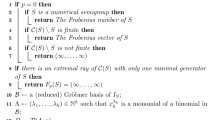A polynomial algorithm is proposed to construct the minimal generating set of solutions and the basis of the solution set for systems of linear Diophantine equations over the ring of integer. The algorithm is based on a modified TSS method.
Similar content being viewed by others
References
S. L. Kryvyi, “Algorithms for solving systems of linear Diophantine equations in integer domains,” Cybernetics and Systems Analysis, No. 2, 3–17 (2006).
G. A. Donets, “Solution of the safe problem on (0,1)-matrices,” Cybernetics and Systems Analysis, No. 1, 98–105 (2002).
A. V. Cheremushkin, Lectures on Arithmetic Algorithms in Cryptography [in Russian], MTsNMO, Moscow (2002).
F. Baader and J. Ziekmann, “Unification Theory,” in: Handbook of Logic in Artificial Intelligence and Logic Programming, University Press, Oxford (1994), pp. 1–85.
R. Allen and K. Kennedy, “Automatic translation of FORTRAN programs to vector form,” ACM Transactions on Programming Languages and Systems, 9, No. 4, 491–542 (1987).
E. Contejan and F. Ajili, “Avoiding slack variables in the solving of linear diophantine equations and inequations,” Theoret. Comput. Sci., 173, 183–208 (1997).
L. Pottier, “Minimal solution of linear Diophantine systems: Bounds and algorithms,” in: Proc. 4th Intern. Conf. on Rewriting Techn. and Appl., Como, Italy (1991), pp. 162–173.
E. Domenjoud, “Outils pour la deduction automatique dans les theories associatives-commutatives,” Thesis de Doctorat d’Universite, Universite de Nancy I (1991).
M. Clausen and A. Fortenbacher, “Efficient solution of linear Diophantine equations,” J. Symbolic Comput., 8, Nos. 1–2, 201–216 (1989).
J. F. Romeuf, “A polinomial algorithm for solving systems of two linear Diophantine equations,” TCS, 74, No. 3, 329–340 (1990).
M. Filgueiras and A. P. Tomas, “A fast method for finding the basis of non-negative solutions to a linear Diophantine equation,” J. Symbolic Comput., 19, No. 2, 507–526 (1995).
H. Comon, “Constraint solving on terms: Automata techniques (Preliminary lecture notes),” in: Intern. Summer School on Constraints in Comput. Logics, Gif-sur-Yvette, France, (1999).
Author information
Authors and Affiliations
Corresponding author
Additional information
Translated from Kibernetika i Sistemnyi Analiz, No. 6, pp. 36–41, November–December 2009.
Rights and permissions
About this article
Cite this article
Kryvyi, S.L. An algorithm for constructing the basis of the solution set for systems of linear Diophantine equations over the ring of integers. Cybern Syst Anal 45, 875–880 (2009). https://doi.org/10.1007/s10559-009-9160-y
Received:
Published:
Issue Date:
DOI: https://doi.org/10.1007/s10559-009-9160-y




